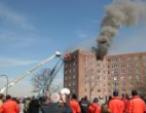
NIST Sets Fires to High-Rise, Tests Firefighting Tactics
National Institute of Standards and Technology fire protection engineers turned an abandoned New York City brick high-rise into a seven-story fire laboratory last month to better understand the fast-moving spread of wind-driven flames, smoke, and toxic gases through corridors and stairways of burning buildings. The experiments on NYC's Governors Island, conducted in partnership with the Fire Department of New York and the city's Polytechnic University, examined the effectiveness of firefighting tactics such as the use of positive pressure ventilation fans, wind control devices and hose streams to control or suppress deadly heat and smoke from the wind-driven fires. NIST expects to issue a report on the experiments by November 2008 with findings that will improve fire service guidelines for combating high-rise fires and enhance firefighter safety, fire ground operations, and use of equipment.
The National Fire Protection Association says that between 1985 and 2002, 1,600 civilians died and more than 20,000 people were injured in approximately 385,000 high-rise building fires in the United States. Due to temperature differences between the outside and inside of a building on fire, open doors and broken windows far from the actual site of the fire can increase the movement of hot gases and smoke dramatically. Wind-driven flames, heat and smoke with temperatures exceeding 1500 degrees F can speed across entire floors and around corridors without warning. Smoke and heat entering stairwells often can block the evacuation of occupants and can hinder firefighting operations.
To develop an understanding of the wind-driven fires and measure the impact of the firefighting tactics, NIST researchers placed cameras, and temperature and pressure sensors throughout the building. From a safe ground-floor monitoring post, the researchers with laptops monitored the progress of intentionally set fires raging through the apartments and public corridors. They recorded, second-by-second, the effects of opening or closing doors and windows both near and far from the blaze. Positive pressure ventilation fans, prototype wind control devices and prototype high-rise fire suppression nozzles, which were developed by FDNY, all had a positive impact on controlling the effects of a wind-driven fires, NIST says. FEMA funded the tests under its "Assistance to Firefighters" grant program.